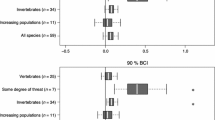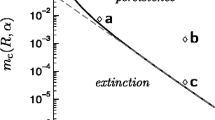Abstract
In this paper three extensions of the Levins metapopulation model are discussed: (1) It is shown that the Levins model is still valid if patches contain local populations of different sizes with different colonization and extinction rates. (2) A more mechanistic formulation of the rescue effect is presented. (3) The addition of preference of dispersers for occupied or empty patches and its consequences for conservation strategies are studied.
Similar content being viewed by others
References
Anderson, R. M. and R. M. May (1991). Infectious Diseases of Humans, Oxford: Oxford University Press.
Brown, J. H. and A. Kodric-Brown (1977). Turnover rate in insular biogeography: effect of immigration on extinction. Ecology 58, 445–449.
Casagrandi, R. and M. Gatto (1999). A mesoscale approach to extinction risk in fragmented habitats. Nature 400, 560–562.
Diekmann, O. and J. A. P. Heesterbeek (2000). Mathematical Epidemiology of Infectious Diseases: Model Building, Analysis and Interpretation, Chichester: John Wiley and Sons.
Etienne, R. S. and J. A. P. Heesterbeek (2000). On optimal size and number of reserves for metapopulation persistence. J. Theor. Biol. 203, 33–50.
Gyllenberg, M. and I. A. Hanski (1992). Single-species metapopulation dynamics: A structured model. Theor. Popul. Biol. 42, 35–61.
Gyllenberg, M. and I. A. Hanski (1997). Habitat deterioration, habitat destruction, and metapopulation persistence in a heterogenous landscape. Theor. Popul. Biol. 52, 198–215.
Gyllenberg, M., I. A. Hanski and A. Hastings (1997). Structured metapopulation models, in Metapopulation Biology. Ecology, Genetics and Evolution, I. A. Hanski and M. E. Gilpin (Eds), San Diego: Academic Press, pp. 93–122.
Hanski, I. A. (1983). Coexistence of competitors in patchy environment. Ecology 64, 493–500.
Hanski, I. A. (1985). Single-species spatial dynamics may contribute to long-term rarity and commonness. Ecology 66, 335–343.
Hanski, I. A. (1994). A practical model of metapopulation dynamics. J. Anim. Ecol. 63, 151–162.
Hanski, I. A. and M. E. Gilpin (Eds) (1997). Metapopulation Biology. Ecology, Genetics, and Evolution, San Diego: Academic Press.
Hanski, I. A. and M. Gyllenberg (1993). Two general metapopulation models and the core-satellite species hypothesis. Am. Nat. 142, 17–41.
Hanski, I. A., A. Moilanen and M. Gyllenberg (1996). Minimum viable metapopulation size. Am. Nat. 147, 527–541.
Hanski, I. A. and D. Simberloff (1997). The metapopulation approach; its history, conceptual domain, and application to conservation, in Metapopulation Biology. Ecology, Genetics and Evolution, I. A. Hanski and M. E. Gilpin (Eds), San Diego: Academic Press, pp. 5–26.
Hanski, I. A. and D.-Y. Zhang (1993). Migration, metapopulation dynamics and fugitive co-existence. J. Theor. Biol. 163, 491–504.
Hasibeder, G. (1996). When susceptible and infective human hosts are not equally attractive to mosquitoes: a generalization of the Ross Malaria Model, in Models for Infectious Human Diseases. Their Structure and Relation to Data, V. Isham and G. Medley (Eds), Cambridge: Cambridge University Press, pp. 206–209.
Hastings, A. (1991). Structured models of metapopulation dynamics. Biol. J. Linn. Soc. 42, 57–70.
Hess, G. R. (1996). Linking extinction to connectivity and habitat destruction in metapopulation models. Am. Nat. 148, 226–236.
Lande, R. (1987). Extinction thresholds in demographic models of territorial populations. Am. Nat. 130, 624–635.
Lande, R. (1988a). Demographic models of the northern spotted owl (Strix occidentalis caurina). Oecologia 75, 601–607.
Lande, R. (1988b). Genetics and demography in biological conservation. Science 241, 1455–1459.
Lande, R. S., Engen and B.-E. Saether (1998). Extinction times in finite metapopulation models with stochastic local dynamics. Oikos 83, 383–389.
Lawton, J. H., S. Nee, A. J. Letcher and P. H. Harvey (1994). Animal distributions: patterns and processes, in Large-Scale Ecology and Conservation Biology, P. J. Edwards, R. M. May and N. R. Webbs (Eds), Oxford: Blackwell, pp. 41–58.
Levins, R. (1969). Some demographic and genetic consequences of environmental heterogeneity for biological control. Bull. Entomol. Soc. Am. 15, 237–240.
Levins, R. (1970). Some Mathematical Problems in Biology, M. Gertenhaber (Ed.), Providence, RI: American Mathematical Society, pp. 75–107.
May, R. M. (1991). The role of ecological theory in planning reintroduction of endangered species. Symp. Zool. Soc. Lond. 62, 145–163.
Moilanen, A. and I. A. Hanski (1995). Habitat destruction and coexistence of competitors in a spatially realistic metapopulation model. J. Anim. Ecol. 64, 141–144.
Nee, S. (1994). How populations persist. Nature 367, 123–124.
Nee, S. and R. M. May (1992). Dynamics of metapopulations: Habitat destruction and competitive coexistence. J. Anim. Ecol. 61, 37–40.
Ray, C., M. Gilpin and A. T. Smith (1991). The effect of conspecific attraction on metapopulation dynamics. Biol. J. Linn. Soc. 42, 123–134.
Author information
Authors and Affiliations
Rights and permissions
About this article
Cite this article
Etienne, R.S. Local populations of different sizes, mechanistic rescue effect and patch preference in the Levins metapopulation model. Bull. Math. Biol. 62, 943–958 (2000). https://doi.org/10.1006/bulm.2000.0186
Received:
Accepted:
Issue Date:
DOI: https://doi.org/10.1006/bulm.2000.0186




